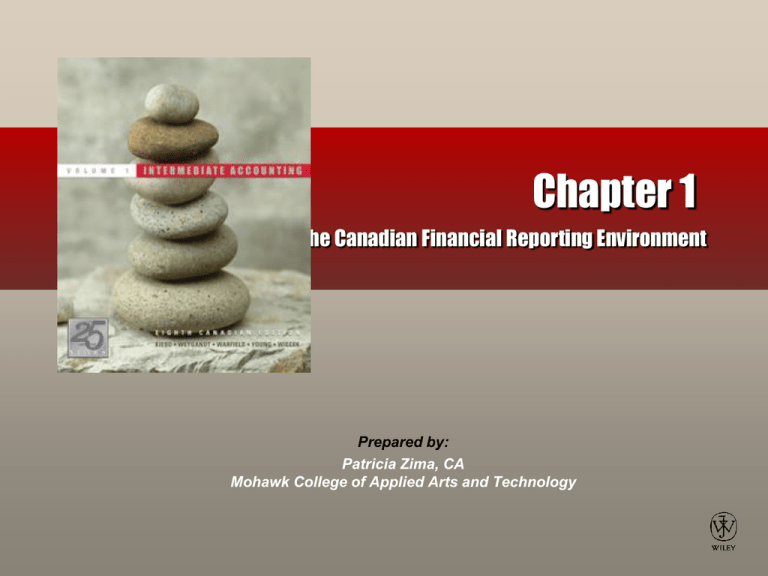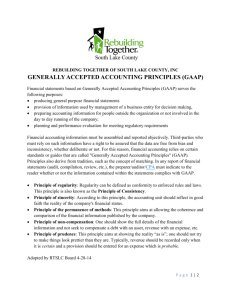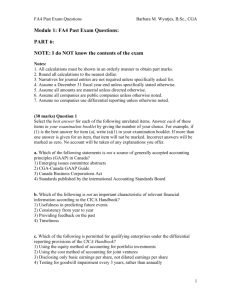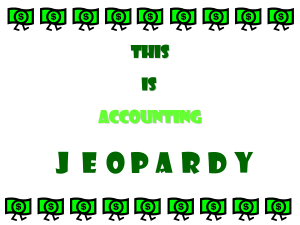
Chapter 1
The Canadian Financial Reporting Environment
Prepared by:
Patricia Zima, CA
Mohawk College of Applied Arts and Technology
The Canadian Financial Reporting
Environment
Role of
Objective of
Financial
Financial
Reporting
Reporting
• Financial
•Management
statements bias
and financial •Users’ needs
reporting
• Accounting
and capital
allocation
•Stakeholders
Standard
Setting
• Need to
develop
standards
• Parties
involved in
standard
setting
• Standard
setting in a
political
environment
GAAP
• GAAP
hierarchy
•Professional
judgement
• Role of
ethics
Challenges
Facing Financial
Reporting
• Globalization of
companies and
capital markets
• Impact of
technology
• Changing nature
of the economy
• Increased
requirement for
accountability
2
Characteristics of Accounting
•
Accounting identifies, measures, analyses, and
communicates financial information to various
users (decision makers)
•
Accounting has two broad classifications:
1. Financial accounting
2. Managerial accounting
•
Accounting theory and practice have evolved and
will continue to evolve to meet changing demands
and influences
3
Characteristics of Accounting
1. Identification, measurement, and
communication of financial information
about;
2. Economic entities to;
3. Interested persons.
4
Financial Reporting
• Financial accounting provides historical information
• Financial reporting is used by both internal and
external users
• External users include such decision makers as
investors, creditors, unions, and government
agencies
• Managerial accounting provides both historical and
forecast information
• Managerial reporting information is used by
management (internal users only)
5
Financial Statements and Other
Means of Financial Reporting
•
Major financial statements include:
• Balance Sheet
• Income Statement
• Statement of Cash Flows
• Statement of Shareholders’ (Owners’)
Equity
+ Note Disclosures
6
Financial Reporting
•
Other forms of financial reporting include:
•
•
•
•
•
President’s letter
Prospectuses
Government reporting
News releases
Management forecasts
7
Flow of Information through the
Financial Statements
Income
Statement
Reports Net
Income
Statement of
Equity
Balance
Sheet
Ending
balance
reported
Change in cash as
reported displays the
change in cash
position
Statement of
Cash Flows
8
Accounting and Capital Allocation
Financial reporting aids users in the
allocation of scarce resources
(capital)
9
Accounting and Capital Allocation
• The accounting profession has the
responsibility of measuring a company’s
performance accurately, fairly, and on a timely
basis
• These measurements enable investors and
creditors to compare the income and assets
employed by companies
• Investors can then assess the relative risks
and returns associated with companies
10
Capital Allocation Process
11
Accounting and Capital Allocation
Financial
Reporting
aids
Financial
statements and
other forms of
financial
reporting
Users
(present and
potential)
Users include:
investors,
creditors,
unions,
government
agencies, and
other
Capital
Allocation
decisions
Involves
determining
how funds are
allocated among
competing
interests
12
Accounting and Capital Allocation
• In Canada, the primary exchange mechanisms
for allocating resources are:
– Debt and equity markets (e.g. TSX)
– Financial institutions (e.g. banks)
13
Sources of Capital
14
Accounting and Capital Allocation
• An effective process of capital allocation is
critical to a healthy economy
• Unreliable information leads to poor capital
allocation
• Credit rating agencies use accounting to rate
companies’ financial stability
• This gives investors and creditors additional
independent information
15
Stakeholders in Financial Reporting
• Stakeholders: parties who have
something at stake in the financial
reporting environment
• Key stakeholders include traditional
users of financial information
16
Stakeholders in Financial Reporting
• Broader definition of users is: anyone who
prepares, relies on, reviews, audits, or
monitors financial information
• Includes both internal and external parties
• Key stakeholders include:
– investors, creditors, auditors, regulators,
analysts, management, standard setters,
and others
17
Stakeholders in Financial Accounting
• Investors and creditors rely on the financial
statements to make decisions
• Standard setters set Generally Accepted
Accounting Principles (GAAP) for direction on
accounting
• GAAP is used to help reduce management
bias and to ensure the information is useful to
users
18
What is at Stake for Each Stakeholder
Stakeholder
What is at Stake?
• Investors &
creditors
• Investment / loan
• Management
• Job, bonus, reputation, salary
increase, access to capital markets
by company
• Securities
commissions
and stock
exchanges
• Reputation, effective and efficient
capital marketplace
19
What is at Stake for Each Stakeholder
Stakeholder
What is at Stake?
• Analysts & credit
rating agencies
• Reputation and profits
• Auditors
• Reputation and profits (companies
are their clients)
• Standard setters
• Reputation
20
Objectives of Financial Reporting
• The CICA Handbook, Section 1000, par. 15 outlines the
overall objective as:
“The objective … is to communicate information that is useful
to … users in making their resource allocation decisions
and/or assessing management stewardship .… financial
statements provide information about:
1. an entity’s economic resources, obligations and
equity/net assets;
2. changes in an entity’s economic resources,
obligations and equity/net assets; and
3. the economic performance of the entity.”
21
Objectives of Financial Reporting
Resource Allocation Decisions
Was income
earned to
generate
future cash?
Yes
Able to meet obligations
and pay a return on
investment
Assess Management Stewardship
Did management’s decisions
on resource acquisition and
allocation increase
shareholder wealth?
Yes
Capital
continues to
be available
Investor and creditor
confidence continues
22
Management Bias
• Preparation of the financial statements are the
responsibility of internal management
• May lead to preparing statements that report the
enterprise in its best light
• Motives include:
– to reflect positive management stewardship (job,
compensation)
– meet financial analysts’ expectations, resulting in
a positive reaction in the capital markets
• What safeguards are in place to protect financial
users from management bias?
23
Understanding User Needs in the
Financial Reporting Process
Management
Prepare the
reports
Users
Use the reports
to acquire capital
Use the reports for
investment/lending
decisions
Financial
Statements
Aggressive financial reporting has a direct impact on the
user’s decision-making process
24
The Need to Develop Standards
• Standards are set to aid preparers and users of
financial statements
• They allow the preparers of the financial
statements to present fairly the operations of the
company
• A single set of financial statements is prepared
to meet the majority of the users’ needs
• Standards are not rules, regulations, or laws
• Standards are intended to be generally
accepted and universally practised
25
The Standard Setting Process in
Canada – Parties Involved
Canadian Institute of Chartered Accountants (CICA)
Accounting Standards Board (AcSB) of the CICA
•
•
–
–
Primarily responsible for setting GAAP in Canada
Two underlying premises for development of standards
– Be responsive to the needs and viewpoints of the
entire economic community
– Operate in full public view through due process
Ensures that companies listed on the exchange prepare
their statements in accordance with GAAP
Key objective to ensure framework for measurement and
reporting facilitates the global flow of capital and serves the
public interest
26
The Standard Setting Process in
Canada — Parties Involved
• Provincial Securities Commission
(e.g. Ontario – www.osc.gov.on.ca)
– To oversee and monitor capital marketplace
– Ensure strict adherence to securities law/legislation
• Financial Accounting Standards Board (FASB)
www.fasb.org and the Securities and Exchange
Commission www.sec.gov
– Major standard setting body in the U.S.
• International Accounting Standards Board (IASB)
www.iasb.org
– Major international standard setting body
27
Generally Accepted Accounting
Principles (GAAP)
• The profession has developed GAAP, which
aids in presenting fairly, clearly, and completely
the financial operations of the enterprise
• GAAP consists of authoritative
pronouncements issued by certain accounting
bodies
• The CICA Handbook is the foremost source for
GAAP
28
The GAAP Hierarchy
•
•
Primary sources
Other sources
Considered only after primary sources
have been researched
29
GAAP Hierarchy–Primary Sources
•
Section 1100 of the Handbook (in order of
authority)
– Handbook Sections (1300-4460)
– Accounting Guidelines
– Background Information and Basis for
Conclusions
– EIC Abstracts
– Illustrative Examples (of the above)
– Implementation Guides
30
GAAP Hierarchy–Other Sources
•
Other sources include:
– Pronouncements in other jurisdictions
– Research studies
– Accounting textbooks, journals, studies,
and articles
– Other
Must be consistent with primary sources
and conceptual framework
31
Professional Judgement
• There cannot be a rule for every situation
• Rules vs. principles
• Standards in Canada are based primarily on
principles rather than specific rules
• Therefore, must use professional judgement
• The United States uses a rules-based
approach
32
Sarbanes-Oxley Act (SOX)
• The Sarbanes-Oxley Act (SOX) was enacted in
2002
• Some of the legislation’s key provisions:
– Public Company Accounting Oversight Board
(PCAOB)
– Independence rules
– Bonus/profit forfeiture
– CEO/CFO certification
– Independent audit committees
– Codes of ethics
33
Challenges Facing Accounting
•Globalization
•Technology
•New economy
•Accountability
Need for international
harmonization of standards
Ability to produce and access
timely information
A move from the traditional
‘resource-based’ to a
‘knowledge-based’ economy
Driven by more sophisticated
and varied investors
34
COPYRIGHT
Copyright © 2007 John Wiley & Sons Canada, Ltd.
All rights reserved. Reproduction or translation of
this work beyond that permitted by Access Copyright
(The Canadian Copyright Licensing Agency) is
unlawful. Requests for further information should be
addressed to the Permissions Department, John
Wiley & Sons Canada, Ltd. The purchaser may make
back-up copies for his or her own use only and not
for distribution or resale. The author and the
publisher assume no responsibility for errors,
omissions, or damages caused by the use of these
programs or from the use of the information
contained herein.
35





